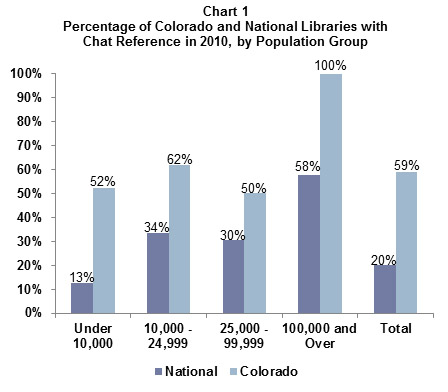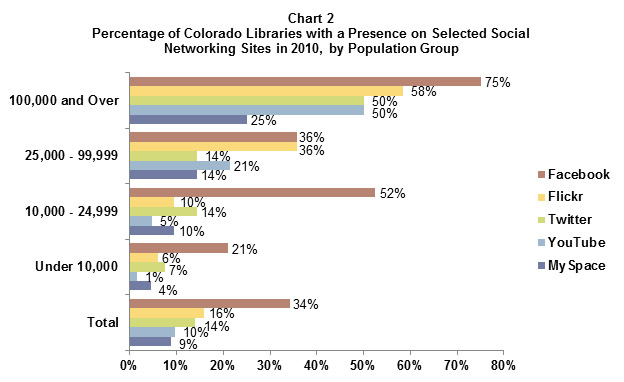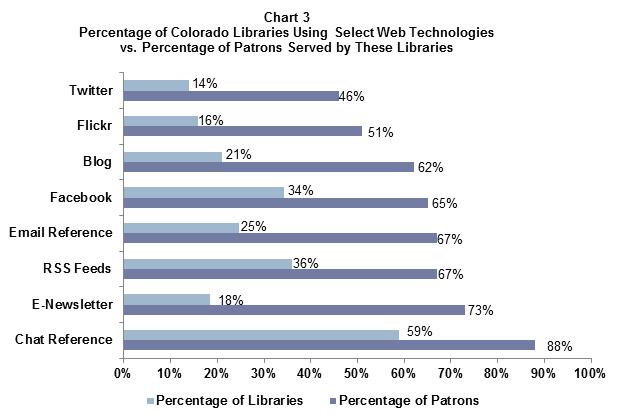In spring 2010, the Library Research Service (LRS) repeated its observational study, first conducted in 2008, of U.S. Public Libraries and the Use of Web Technologies.[note]Visit the LRS website for the Closer Look Report on the original study, as well as a Fast Facts covering the 2008 Colorado results http://www.lrs.org/public/webtech/.[/note] The 689 libraries included in the study were selected as a random sample of public libraries across the country, broken down into 5 population groups and including all 114 public libraries in Colorado. LRS staff members visited the libraries’ websites—if they had one—to see what the libraries were doing with their web presences. The second round of the study led not only to comparisons between Colorado libraries and their counterparts across the country, but also to updates of what changed in the two years between studies.
Web Presence, Online Account Access, and Chat Reference
In general, Colorado results mirrored those of libraries nationwide. The percentage of libraries maintaining a website and offering patrons online access to their accounts showed minor increases over 2008 numbers, as the majority of libraries already provided these services. In 2010, at least 9 in 10 Colorado public libraries serving more than 10,000 people had websites and online patron account access – about the same as the percentages nationwide. The smallest Colorado libraries (those serving fewer than 10,000) are noticeably ahead of their peers nationwide in these two areas, with 8 in 10 maintaining a website and 6 in 10 offering online account access, compared to 7 in 10 and less than 5 in 10 (45%), respectively, nationwide. The ability for small Colorado libraries to maintain their own websites is undoubtedly supported by Plinkit, a turnkey website hosting solution managed and maintained centrally in Colorado by the State Library.
Another collaborative effort that has allowed Colorado public libraries to surpass the national average is AskColorado, a statewide chat reference service mananaged by the State Library. At least half of all Colorado public libraries, and all of those serving more than 100,000, provide chat reference – a much higher percentage than libraries nationwide (see Chart 1). At the time of the study only one Colorado library with chat reference did not use AskColorado. The service remains the most common form of online reference for Colorado libraries, more popular even than email.
Social Media and RSS Feeds
While some of the older, more basic web technologies such as blogs and email reference appear to have stagnated in rate of adoption, more interactive tools continue to grow in popularity. An excellent example is Facebook, and social media in general. In 2008, just 5 percent of Colorado public libraries were experimenting with any kind of social media, and those efforts were limited to MySpace and Flickr. None had ventured onto Facebook. Two years later, 1 in 3 (34%) had an account, about the same percentage as libraries nationwide. That increased to 3 in 4 libraries serving more than 100,000 and 1 in 2 libraries serving 10,000-24,999 (see Chart 2). Flickr and Twitter are becoming more common as well, but MySpace—once the most popular social media site for libraries—is now the least used. Colorado libraries’ social media presence reflects that of libraries nationally, with Colorado libraries just edging ahead in use of Facebook, Flickr, Twitter, and YouTube.
In addition to social networking sites, a growing number of Colorado libraries are making use of another tool that requires more user participation: RSS feeds. RSS feeds allow library users to sign up for regular announcements or updates of content from their libraries’ websites, including blog posts and new additions to the catalog. More than 1 in 3 (36%) Colorado public libraries use RSS feeds in some way, up from 13 percent in 2008. The greatest growth came in libraries serving 25,000-99,999, from less than 1 in 10 to 1 in 2. All but the largest Colorado libraries are considerably ahead of the national sample in offering RSS feeds.
Overall Results
Disregarding size, at least half of all Colorado public libraries maintain websites that provide online access to patrons’ accounts, a search box, and chat reference services. About a third use RSS feeds or Facebook, but beyond that, implementation of various Web 2.0 technologies drops to just 1 in 4 libraries or less. National estimates follow a similar trajectory, but Colorado libraries maintain a higher percentage of use for all technologies except MySpace and SMS reference. The same is true when considering the percentage of patrons served by libraries using these tools.
The majority of Colorado public library jurisdictions serve communities of fewer than 10,000 people and are less likely than larger libraries to experiment with Web 2.0 tools. As a result, some Web 2.0 technologies were relatively uncommon on library websites overall; nevertheless, they reached a much larger estimated percentage of patrons.[note]LRS staff arrived at these estimates by summing the LSA populations of all the libraries using each technology and dividing that by the total number of patrons in the state.[/note] All but 2 of the technologies included in the study (text reference and MySpace) reach at least 1 in 3 Colorado library patrons. For instance, just 1 in 3 libraries use Facebook, but 2 in 3 Coloradans are served by a library that has a presence on the social networking site (see Chart 3). When looking at the percentage of patrons served, chat reference again presents a noticeable gap between Colorado and the nation. Nearly 9 in 10 (88%) Colorado patrons have access to a library that offers the service – twice the estimated percentage of patrons nationwide (44%).
Early Adopters
By rating all libraries on an index of the number of web technologies adopted, LRS staff identified which were “Early Adopters” (i.e., the top 20 percent of each population group from the national sample). A growing number of Colorado libraries are performing better in regard to this measurement; nearly 1 in 10 (9%) scored half the possible points on the index, whereas in 2008 no libraries in the state reached that benchmark. When compared to non-early adopters, Early Adopters demonstrated higher inputs and outputs in areas traditionally measured to indicate library success, such as visits and circulation (see Chart 4). Additionally, Colorado Early Adopters reported having more librarians and staff and higher revenue. In fact, Early Adopters had higher numbers in all but one measure included in the study—print volumes per capita. Although not all of these differences were statistically significant, more were significant in 2010 than in 2008, supporting previous observations of a trend in tech-savvy libraries being more successful. Interestingly, Colorado libraries that were not Early Adopters reported more electronic users and computers per capita than Early Adopters nationwide, indicating that in some areas, all Colorado libraries are ahead of the curve.
Conclusion
Since 2008, Colorado public libraries have shown minor increases in their adoption of basic web technologies, such as maintaining a web presence and offering online access to patrons’ accounts. Chat reference remains a popular feature of Colorado library websites, thanks to statewide service AskColorado, but likewise showed relatively small growth. At the same time, use of social media sites and RSS feeds has skyrocketed. While the Colorado results reflected those of the national sample, libraries in the state tended to be ahead of libraries across the country in most areas. A higher percentage of Colorado libraries, compared to the national sample, use each of the technologies included in the study except MySpace and SMS reference. Furthermore, libraries that utilize these tools reach an even greater percentage of patrons than do libraries nationwide. Colorado Early Adopter libraries—those using more web technologies—reported higher numbers for all but one of the measures typically used to indicate library success. For more details, including results from the national sample, see the Closer Look Report U.S. Public Libraries and the Use of Web Technologies, 2010, on the LRS website http://www.lrs.org/public/webtech/.



